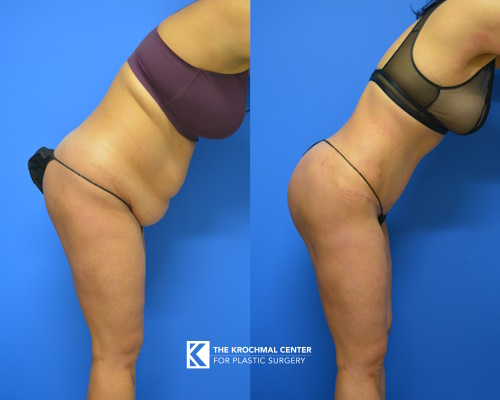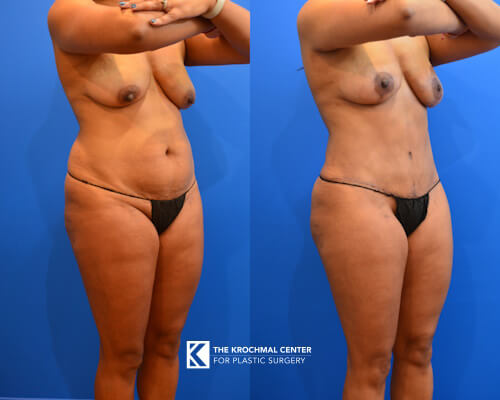At The Krochmal Center for Plastic Surgery

Watch Dr. Daniel Krochmal, MD, FACS review Tummy Tucks at The Krochmal Center for Plastic Surgery.
Dr. Daniel Krochmal, MD, FACS answers your most common questions about Tummy Tuck Procedures
An Abdominoplasty (AKA “Tummy Tuck”) is a procedure to improve the appearance of the stomach area by removing the excess skin and fat. Excess skin can result from things such as pregnancy and significant weight loss, and an Abdominoplasty is a wonderful way to improve the shape of the torso. There are many variations of the traditional Abdominoplasty, including a “mini Tummy Tuck” (where the small scar is about the length of a C section), “extended Tummy Tuck” which allows for extra contouring of the flanks and upper-outer thighs, “Circumferential Abdominoplasty” or “body lift” where the buttocks and lower back are also addressed, “Reverse Abdominoplasty” which removes the skin and fat in the upper stomach area and leaves a scar hidden under the breasts, and a “Fleur de Lis Abdominoplasty” where much of the excess skin in the central abdomen is also removed (typically done in patients with very significant weight loss). The well-healed scars are easily hidden in clothing, with additional emphasis on creating a cute, youthful belly button.
You may have also heard the term “Mommy Makeover”. A “Mommy Makeover” is a general term used to describe a combination of procedures done to get a patient back into their “pre-mommy body”, including a Tummy Tuck and some form of breast procedure (Breast Augmentation, Breast Lift, Breast Reduction, etc.). If you’re considering a Tummy Tuck surgery, you may want to consider additional procedures to be performed at the same time to limit the amount of surgeries you have and the additional recovery time.
An Abdominoplasty or Tummy Tuck procedure is typically done under general anesthesia for patient comfort. Many times the skin/fat removal is combined with a muscle repair where the rectus abdominis muscles are stitched together if they are separated (called a “rectus diastasis). To reinforce the muscle repair in patients with a “weak” abdominal wall, Dr. Krochmal likes to use GalaFlex mesh for additional strength and longevity. Many surgeons (including Dr. Krochmal) also perform extra body shaping with advanced Liposuction techniques to further refine the appearance. You may know of terms such as “Circumferential Liposuction”, “360 Lipo”, “Hi-Def Lipo”, or “etching” that can be used with Abdominoplasties. Basically, the variations performed are individualized to create the most ideal outcome for you in the safest way possible.
A good candidate for an Abdominoplasty or Tummy Tuck is anybody who is unhappy with the appearance of their stomach due to extra skin. Ideally, a person should be close to their “goal weight” and be in generally good health prior to the procedure to maximize safety and the end result.
Some patients, no matter how hard they try, cannot get to their ideal body weight. Oftentimes this is due to significant abdominal tissue that is hindering their weight loss goals. By removing that extra skin and fat from the stomach area, this may stimulate weight loss because now workouts will become more efficient and it’ll become easier to burn calories! While some plastic surgeons do not operate on overweight/obese individuals, others (including Dr. Krochmal) perform these “plus-size Abdominoplasty” procedures with some modifications to maximize safety and limit potential complications.
In the name of safety, there may still be times when a surgeon asks patients to lose more weight before undergoing body-contouring surgery. Dr. Krochmal works closely with nutritionists, personal trainers, and bariatric surgeons to assist patients in achieving their lifelong goals of living healthy lifestyles with shapes they’re happy with!
There is no “best” surgeon for any procedure. But, there are some qualifications and credentials that improve the chance that you will achieve your desired result safely. Make sure your surgeon is a Board Certified Plastic Surgeon. Make sure they operate in a fully accredited facility. If the procedure is not being done in a hospital, make sure they have privileges at a local hospital to do the procedure you are getting done. Make sure they have completed an accredited residency or fellowship program. Ask if they do research on that particular procedure (Dr. Krochmal does research on preventing blood clots/DVT’s after tummy tucks using certain medications). Read their reviews to get a sense of what other patients have experienced. Check out their before/after pictures to get a sense of their technical and artistic style, and see if they operate on patients who appear similar to you.
And most importantly, schedule a consultation with that doctor to see if they are a good “fit” for you. Every doctor has his or her own personality and approach to patient care, so you will want to see if you like that particular approach. Do they inspire confidence and trust? Are they calming and reassuring? Do they take the time to answer your questions? Do they discuss alternative approaches and say why those approaches may or may not work? Do they seem like they will continue to care for you after the procedure?
There is no “best Abdominoplasty surgeon”, but there is a “best” surgeon for you. You just may need to consult with several to find the right one. Hopefully Dr. Krochmal is on your “short list” of Chicago and Hinsdale plastic surgeons to interview. We’re happy to help Shape Your Future!
The cost of a Tummy Tuck can be between $10,000 – $20,000.
A Tummy Tuck result is permanent in the sense that even if your skin and muscles do continue to stretch with time, your result will always be better than if you had never undergone the surgery.
You should get a Tummy Tuck if you desire to have a thinner, smoother, flatter abdomen after pregnancy or weight loss (or “bad luck” from your parents).
Dr. Daniel Krochmal, MD, FACS shares real patient results from Tummy Tuck at The Krochmal Center for Plastic Surgery.

37 yo Female 3 Months Following Abdominoplasty with Liposuction to her Abdomen and Back with Buttocks Fat Grafting (BBL).

53 yo Female 3 Months Following Fleur de Lis Plus-Size Abdominoplasty with Abdominal Liposuction.

42 yo Female 10 Months Following Plus-Size Abdominoplasty with Liposuction to her Abdomen and Back (also had a Bra Line Backlift).

37 yo Female 5 Months Following Abdominoplasty with Liposuction to her Abdomen and Back (Also Had Buttocks Fat Grafting and a Breast Augmentation with Implants to Complete the “Mommy Makeover”).

36 yo Female 2 Years Following Plus-Size Abdominoplasty with Abdominal Liposuction (Also Had Back Contouring, Arm Contouring, and Thigh Lift at a Later Surgery).

32 yo Female 3 Months Following Plus-Size Abdominoplasty with Abdominal and Back Liposuction (Also Had Fat Grafting to her Breasts with a Donut Mastopexy to Complete the “Mommy Makeover”).

43 yo Female 6 Months Following Abdominoplasty with Liposuction to her Stomach and Lower Back (Also Had a Bra Line Backlift).

42 yo Female 5 Months Following Abdominoplasty with Liposuction to her Stomach and Back.

42 yo Female 3 Months Following Abdominoplasty with Liposuction to her Stomach and Lower Back (Also Had Breast Implant Exchange).

64 yo Female 3 months following Abdominoplasty with Abdominal and Hip Roll Liposuction.

39 yo Female 3 Months Following Abdominoplasty with Abdominal and Hip Roll Liposuction (Also Had a Breast Lift to Complete the “Mommy Makeover”).

36 yo Male 3 Months Following a Circumferential Abdominoplasty (Also Had a Torsoplasty).

44 yo Female 3 Months Following Abdominoplasty with Liposuction to her Stomach and Back (Also Had a Breast Augmentation with Implants to Complete the “Mommy Makeover”).

52 yo Female 2 Months Following a Circumferential Fleur de Lis Abdominoplasty (Includes a Buttocks Lift).